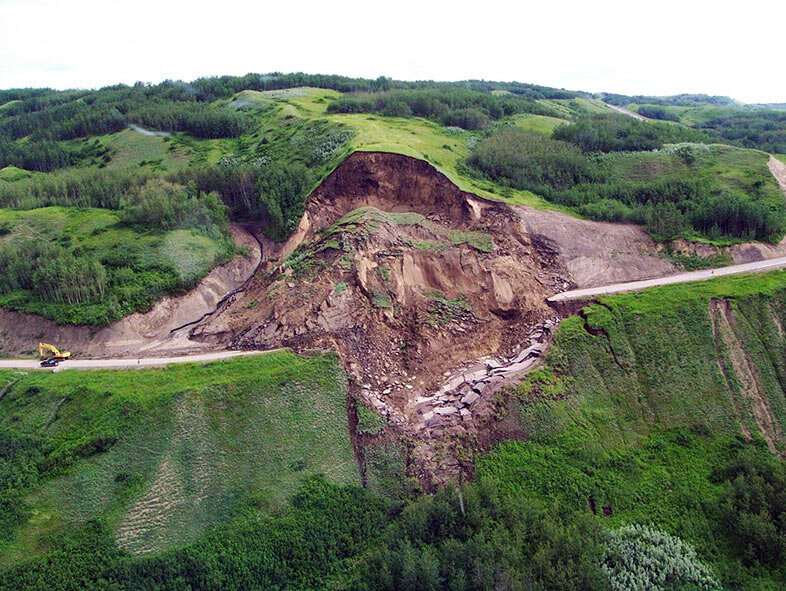Tehran exposed to landslide, land subsidence

TEHRAN – Landslide and land subsidence are the two major threats in the Iranian capital city of Tehran, which will pose threat to the lives of at least 3 million people, Ali Beitollahi, secretary of the national working group on natural disasters has warned.
Referring to the differences between landslide and land subsidence, he noted that landslide refers to a wide range of ground movements, such as rock falls, deep-seated slope failures, mudflows and debris flows. It is triggered by some specific events such as heavy rainfall, earthquake, slope cut to build a road, and many others, although this is not always identifiable.
“Subsidence is the sudden sinking or gradual downward settling of the ground's surface with little or no horizontal motion. It may be caused by natural processes or by human activities. The human activities include sub-surface mining or extraction of underground fluids, or groundwater.”
Iran is greatly affected by both phenomena, while landslide is more common in the capital, he lamented, ISNA reported on Sunday.
Referring to the areas prone to landslide in Tehran, he noted that southern part of the city is more exposed to the threat due to shaking caused by underground transport system.
“Landslide causes huge holes to open up in the ground, which makes it different with land subsidence, however, both are threatening the country.”
He went on to say that Tehran districts 17, 18 and 20 are prone to land subsidence, which is mainly caused by excessive groundwater withdrawal; when large amounts of groundwater have been withdrawn from certain types of rocks, such as fine-grained sediments, the rock compacts because the water is partly responsible for holding the ground up.
“So, when the water is withdrawn, the rocks falls in on itself, and land subsidence cannot be noticed early because it can occur gradually over large areas rather than in a small spot.”
For example, in southern Tehran, ground sinks about 20 to 25 centimeters annually on a large scale, if it continues over a long period of time, the land downwards about 6 meters over a thirty-year period, leading to cracking of the buildings as well as gas, oil and sewer pipes, he explained.
Southern areas of the capital are extremely old, which are highly vulnerable to subsidence and landslide, he stated, adding, about 3 million people are residing the areas affected by both threats.
Landslide harshly hit Lorestan province
Meanwhile, Reza Saki, an environmentalist, has warned that Lorestan province cannot bear the consequences of rainfall, the city is highly vulnerable to flood, Mehr reported on Sunday.
The province of Lorestan has been haunted by flood on March 19 which caused huge devastations in addition to landslides which occurred in 1,300 parts of the province, he lamented.
Large holes have been found in in the province, especially in oak forests, he said, adding, many mountain rocks have been moved and displaced, and a large amount of soil flowed downward carrying many trees.
Each 500-year old oak tree is worth $200,000 for its ecological value, while flood has depleted an oak tree aged over 800 years in the province, he noted.
“More importantly, even when a forest burns, we may be able to start reforestation months later and regenerate the area in the long run, but when a landslide occurs, trees are
completely depleted and almost gone forever.”
On the other hand, when landslide wipe out the trees, the area will be more vulnerable to flooding, as the trees act like barriers to flood and reduce its devastation, but the province is
currently suffering from lack of trees and vegetation, so the next flood might wash off the whole province, he regretted.
He further called on the responsible bodies to help save the province of Lorestan, reforestation and water resources management are the two most important measures which must be taken urgently.
Land subsidence an overlooked threat to the country?
Yahya Jamour, deputy director of Iran National Cartographic Center, said in April that although land subsidence is too subtle to be detected, it must be tackled before incurring great loss, which has been proved to be more destructive than flood and earthquake.
“Recent floods were not the first natural disasters and definitely will not be the last, so we must be prepared before the incidents.”
In September 2018, geologist Mohammad Javad Bolourchi said that over 300 plains in Iran are at high risk of experiencing land subsidence, and as long as there is virtually no reduction in illegal overuse of groundwater resources, curbing subsidence will coincide with depletion of aquifers.
Studies in the Iranian calendar years 1388 (March 2009-March 2010), 1390 (March 2011-March 2012), and 1392 (March 2013-March 2014), indicated that the plains in southern Tehran are subsiding by an average of one millimeter a day (36 centimeters a year).
In the Iranian calendar year 1384 (March 2005-March 2006), the subsidence rate in Tehran plain has been measured at 17 centimeters a year, it has been measured 12 centimeters in Varamin county, in southern Tehran.
This is while the run-down in plains of Mashhad or Rafsanjan, which has set the record high for this phenomenon since the Iranian calendar year 1345 (March 1966-March 1967), is certainly higher, regarding the reduction in precipitation rate.
FB/MG
